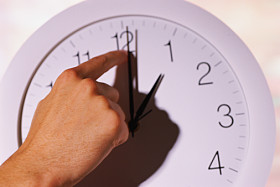Daylight Saving Time: Stressful Time or Regular Day, Depending on Your Clock System.
With the sporadic tease of warm weather and the fact that Daylight Saving Time is right around the corner, many people have already checked into “spring-time mode.” All of a sudden, going for a walk seems like a better idea than it normally would; attending baseball games is a priority that is steadily increasing in importance hour-by-hour; playing music a little louder somehow seems to better the quality of a song when the wind blows in one’s face while driving. The list goes on and on. The central theme around winter time leaving and spring weather arriving is people generally tend to positively embrace Mother Nature. With that being said, many individuals and organizations forget to change their clocks to the correct hour. This little lapse of judgment, due to getting excited about the weather and accidently ignoring the little things while on the job, can lead to all sorts of problems. Workers can go on break an hour earlier or later than planned. Conferences and strict deadlines can be mistakenly neglected. The fact of the matter is that, although it may seem like it’s really not a big deal, it is important to be prepared for Daylight Saving time. Having a synchronized clock system, namely a Sapling system, can make this process empathically less cumbersome.
Daylight Saving time has a particularly strong effect on organizations that conduct daily activity in large buildings or structures. When one changes the time on every clock individually, there is a very low probability that all the clocks will be synced accurately to the second. One person only has two hands, it is physically impossible to change the time on multiple clocks and start them at the exact time. Although these few seconds of difference will not, in every situation, make a significant impact on an organization, there are always rare exceptions that could be damaging; plus having assurance of accuracy and reliability provides relaxation throughout the organization in general. It’s one less thing to worry about for everyone. A master clock can be purchased with a Sapling clock system. A primary use of the master clock is to transmit one time to all of the clocks in the system. This diminishes any issue regarding having a uniform time throughout the building. Even if someone can get a handful of employees to adjust each one of the respective clocks an hour forward or backward in uniform fashion, there is always a chance that at least one is a second or two off and time that is generally used for productivity is thoroughly wasted for that day for the employees involved. When using a master clock in collaboration with a Sapling clock system, one can establish the time change throughout every clock in the building in approximately 5 minutes. This ensures that any incompetence due to lack of uniformity of time is no longer something to worry.
All in all, Sapling products provide comfort and stability for their users. Instead of manually moving every clock in the vicinity an hour forward or an hour backward and risking an extremely high chance of unreliability, purchasing a Sapling system gives one the luxury to switch the time of every clock in the system simply by scheduling the change on the master clock. This makes the potential burden that comes with Daylight Saving time virtually nonexistent. Sapling products benefit their users by allowing them to remain in “spring-time mode” for a longer period of time without the risk of forgetting to adjust the times being displayed in their respective vicinities.

